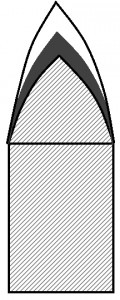War Thunder Ground Forces Tank Shells Guide
War Thunder Ground Forces Tank Shells Guide by LB95
Prologue
I had the idea for this guide a while ago, and it’s something I could have done with during the CBT. Seeing all the “APSFIDUTOG” crap on the shells initially threw me off, and left me just taking full loads of whatever looked the best. And I know I’m not the only one who suffered this.
After doing some research, and looking around, I think I have a comprehensible enough knowledge to at least advise people on which shells they should be taking and using in specific situations.
The Basics
There’s a very simple naming system to the shells, as it’s designed to help real armourers know what they’re loading. When you know what means what, you won’t have to reference this guide, you can just wing it, and know what the shell is by the name.
I’ll use the Russian 122mm cannon as an example, it has one of the fancier shells:
If we look at the BR-471B shell, we can see a long and complex name:

But in actuality, this tells us everything about the shell we need to consider. There’s three parts:
AP- Armour Piercing
HE- High Explosive
BC- Ballistic Cap
This means that the shell pierces armour, explodes, and has a cap to improve it’s ballistics. I’ll go into further detail on this shell later on.
INDEX
Ctrl+F the bold stuff in here to get to a specific shell fast:
#AP1 AP
#AP2 APC
#AP3 APCBC
#AP4 APCR
#AP5 APCNR
#AP6 APDS
#AP7 APHE
#AP8 APHEBC
#HE1 HE
#HE2 HEAT
#HE3 HESH
Shells
Now I’ll go into detail with specific shell bases:
AP #AP1
There’s many variations of simple AP shells, from the APHEBC-T shells on the IS-2, right down to the simple AP shot on the sherman.
Starting at the bottom:
AP- Armour Piercing
This is as simple as it gets, just basically a metal slug that gets shot at the enemy.
When to use this: When you don’t have any better options.
———————————————–
APC- Armour Piercing Capped #AP2
A slight improvement on the base AP, this shell has an added cap of soft metal atop the standard AP shell. The purpose of this is to stop the shell shattering, as the softer metal takes out some of the initial shock, and helping the AP part cut through instead of just being blunted by hardened armour.
When to use this: When you don’t have any better options
————————————————————————-
APCBC- Armour Piercing Capped (Ballistic Capped) #AP3
Again similar to the earlier AP shell, only in addition to the AP cap, it has a “Ballistic cap” which improves it’s ballistics (aerodynamics), so it’s a better shell at long ranges, both more accurate and holds more energy when it gets there.
When to use this: When you’re within range of a target, usually this shell will be able to hit many vital components, and will often bounce around inside, killing crew and igniting fires.
—————————–
AP conclusion
The thing behind choosing between pure AP shells is literally penetration. They’re simply lumps of metal with stuff added on, so you’re going to want to go for the one with the fanciest name or the one with the highest penetration.
Special AP shells
The basis of these shells is to have a small, dense penetrator moving as fast as possible, to get the most amount of kinetic energy focused on the smallest possible point. Because of this, they have very high penetration values and many people take full loads of APCR, assuming it to be the best shell (I myself was included in that).
They do this by having a very dense core surrounded by a light metal shell. Usually a tungsten core with an aluminium outer shell.
The thing with these shells, is no HE filler, and they only make a small hole. This means that unless you’re aiming for specific spots, minimal damage is done.
————————————————————
APCR- Armour Piercing Composite (Rigid) #AP4
This shell is a common one, and one that is commonly used incorrectly.
The basic APCR shell is a tungsten penetrator, surrounded by a light aluminium casing, for maximum penetration.
When to use this: When you’re at extreme ranges, or facing an enemy with armour you know you won’t be able to penetrate with any other shell. This shell is literally a last ditch shell, a just in case.
Because the casing around the shell stays with the core, it produces drag for the length of the flight, so the shell isn’t as good at ranges as a heavier shell in general, but it can still be useful.
There is of course, shells that lose their casing’s drag, so they’re much better at ranges:
—————————————————————-
APCNR- Armour Piercing Composite (Non Rigid) #AP5
Commonly called “squeezebore”, this shell is similar to standard APCR, only that the shell isn’t rigidly fixed in place, so the outer (softer) area is squeezed in. This has the effect of making the shell much more effective at longer ranges than standard APCR.
Used in the British QF 2pdr gun, with the littlejohn adaptor.
This changes the 40mm 2pdr into a ~30mm gun, by squeezing the shell.
When to use this: Instead of APCR, as it’s just a more effective shell.
———————————————————
APDS- Armour Piercing, Discarding Sabot #AP6
Another improvement over standard APCR, this shell is purely the dense penetrator, as the softer casing (sabot, in this case), falls away Soon™ after firing, leaving just the penetrator to continue on, without the drag of the outer shell.
Used in only the British QF 6pdr. 17pdr and 20pdr weapons.
When to use this: Same conditions as the other special penetrators, long ranges and against thick armour.
—————————–
Special AP conclusion
Right now all we have in game is APCR, and it’s a very situational shell, only to be used when you can’t deal damage with any other shells. APCNR and APDS are improved versions, but follow much the same rules, and shouldn’t be used at all times.
APHE shells
Similar to the standard AP shells, only they carry a small amount of explosive filler with them, and explode a short time after coming into contact with something (whether they penetrate or not)
—————————————————–
APHE- Armour Piercing High Explosive #AP7
Exactly as you’d expect. AP, with some HE. Shell goes in (hopefully), shell explodes: Dead tank.
Main components of this shell, are the standard AP cap, with a HE segment, in the centre. This HE section is triggered by a fuse in the nose of the shell.
When to use this: Pretty much as a default shell, unless a better version is available, with a cap.
———————————————————————————
APHEBC- Armour Piercing High Explosive Ballistic Capped #AP8
Very similar to the APHE, only with a ballistic cap, which we covered earlier, so it’s pretty much a better APHE shell
When to use this: In stead of APHE, at longer ranges.
———————-
APHE conclusion
APHE should be your go to shell. The one that you have loaded at all times, as it’s a very good general purpose shell. The AC shell on the KV-2 is just a variant of an APHE shell, only it’s designed to destroy buildings, not necessarily tanks.
HE shells
————————-
HE- High Explosive #HE1
Flat HE is a simple shell, and should only be used on large guns. I’d reccomend not using it on anything smaller than the 122mm guns, and even on the long barreled 122mm (D-25), it’s extremely strange, and often does minimal damge.
The shell is just a wall, with a HE filler within:
When to use this: When you have a large gun, and want to cripple a tank. On the 152mm cannon, use ONLY this shell, if it doesn’t kill something outright, they’ll have upwards of a 10 minute repair.
——————————————–
HEAT- High Explosive Anti Tank #HE2
This shell makes use of a shaped charge in the front, which sprays a jet of molten copper into whatever it hits. This shell is decent at long ranges, as it relies almost entirely on chemical energy.
It should be noted that HEAT generally fires at a lower velocity so that the shell can do it’s job on impact instead of being destroyed completely when it hits. Take this into account when firing at range.
When to use this: If you have the stubby 75’s on the early german tanks. Other than that, there’s not much use, and it seems to be behaving weirdly at the moment [1.41].
————————————————–
HESH- High Explosive Squash Head #HE3
A special use shell used on the British L9A1 165mm demolition gun (only weapon in the timeline that fires this shell, it was used often on the L7A1 105mm cannon (1956)). It’s similar to a HE shell, except it flattens out when it hits a tank before exploding. The plastic explosives within spread across an area on the tank, and explode, sending a shockwave through the armour that sends a scab of metal flying off the other side, destroying whatever is in it’s way.
Just like HEAT, HESH fires at a lower velocity, so it can properly release it’s chemical energy.
When to use this: When something needs to go away. Fast.
HE Conclusion:
HE is useful for smaller targets, and killing cannon barrels of stubborn big tanks. HEAT is very useful on lower tiered tanks, especially when it’s penetration is higher than the AP (KwK37).
Conclusion:
Sorry this is kind of a mess, I added the ctrl+F thing to try ease the fustercluck.
The main shells you’re going to want to use are going to be APHE of some kind for the main damage dealing, and a special shell for dealing with what your APHE can’t.
For example, with the IS-2, I take 23 APHEBC, and 5 HE. I use the HE on Ferdinands and particularly stubborn Jagdpanthers or Tiger II (H)’s.
And with the T-34-57 mod 43, I take about a 30/70 split of APCR and APHE.












Recent Comments